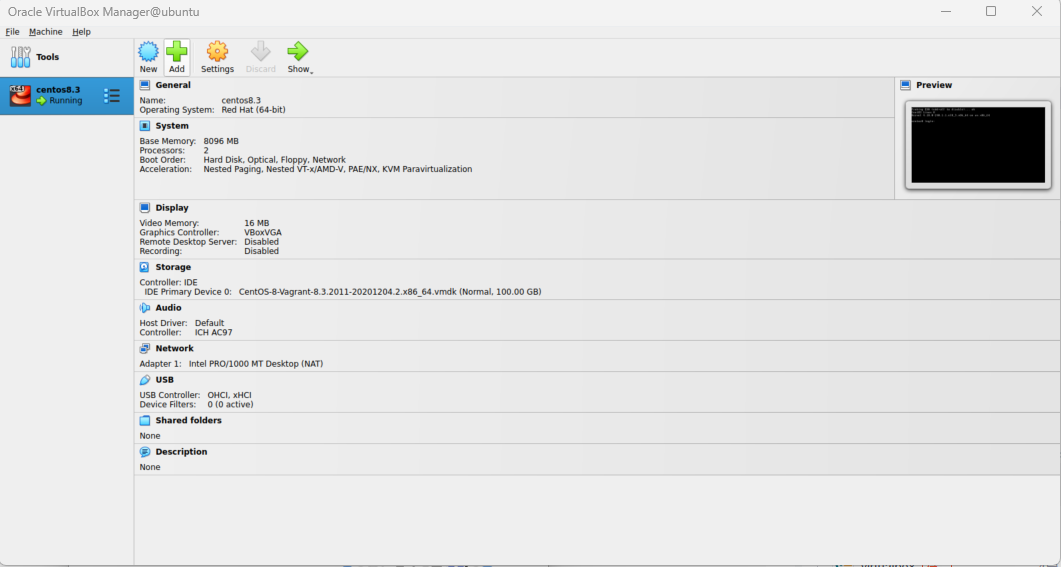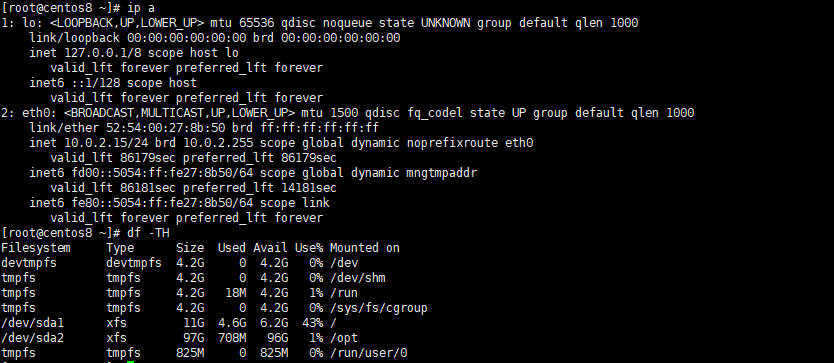
前言
- vagrant 导入centos 虚拟机
前提要求
创建一键部署centos 虚拟机
-
/opt/vagrant 安装目录
-
/opt/VirtualBox 安装目录
-
/opt/centos8/Vagrantfile (可配置网络IP,内存,cpu,磁盘及分区,启动项,虚拟化开启,usb3.0,安装软件) 参考
-
用户名密码 root:1234@com,vagrant:1234@com 远程连接端口 2220
-
虚拟机内部挂载了分区/opt/ 90G ,根据主机需要更改即可 63行 66 行是增加新分区
-
/usr/lib/systemd/system/vagrant-autostart.service 开机启动脚本
-
/usr/bin/vagrant_start.sh 启动脚本,可以执行批量启动关闭
-
vagrant_stop.sh 关闭脚本,可以执行批量启动关闭
-
/var/log/vagrant_startup.log 启动日志记录
-
/var/log/vagrant_shutdown.log 关闭日志记录
-
box 导入参数参考
-
导出参考
vim /vagrant_import_centos.sh
#!/bin/bash
-- coding: utf-8 --
Author: make.han
Date: 2025/04/10
vagrant centos
<<!
vagrant vm
https://portal.cloud.hashicorp.com/vagrant/discover
vagrant docs
https://developer.hashicorp.com/vagrant/docs
vagrant download
https://releases.hashicorp.com/vagrant
vagrant gitlab
https://github.com/hashicorp/vagrant/releases
vagrantfile config
https://developer.hashicorp.com/vagrant/docs/vagrantfile/machine_settings
vagrant 常用命令参考
vagrant init # 初始化
vagrant up # 启动虚拟机
vagrant halt # 关闭虚拟机
vagrant reload # 重启虚拟机
vagrant ssh # SSH 至虚拟机
vagrant suspend # 挂起虚拟机
vagrant resume # 唤醒虚拟机
vagrant status # 查看虚拟机运行状态
vagrant destroy # 销毁当前虚拟机#box管理命令
vagrant box list # 查看本地box列表
vagrant box add # 添加box到列表
vagrant box remove # 从box列表移除
!echo "create centos directory"
mkdir -p /opt/centos8
cd /opt/centos8echo "add init config"
cat <<'EOF'>>/opt/centos8/Vagrantfile-- mode: ruby --
vi: set ft=ruby :
Vagrant.configure("2") do |config|
# The most common configuration options are documented and commented below.
# For a complete reference, please see the online documentation at
# https://docs.vagrantup.com.# Every Vagrant development environment requires a box. You can search for # boxes at https://vagrantcloud.com/search. config.vm.box = "centos8.3" # hosts name config.vm.hostname = "centos8" # 默认启动磁盘大小 config.vm.disk :disk, size: "100GB", primary: true # Add new disks (需要安装插件vagrant plugin install vagrant-disksize) #config.disksize.size = "80GB" # Set the guest operating system type (:linux :windows) config.vm.guest = :linux # Disable automatic box update checking. If you disable this, then # boxes will only be checked for updates when the user runs # `vagrant box outdated`. This is not recommended. # config.vm.box_check_update = false # Create a forwarded port mapping which allows access to a specific port # within the machine from a port on the host machine. In the example below, # accessing "localhost:8080" will access port 80 on the guest machine. # NOTE: This will enable public access to the opened port # config.vm.network "forwarded_port", guest: 80, host: 8080 # Create a forwarded port mapping which allows access to a specific port # within the machine from a port on the host machine and only allow access # via 127.0.0.1 to disable public access # config.vm.network "forwarded_port", guest: 80, host: 8080, host_ip: "127.0.0.1" config.vm.network :forwarded_port, guest: 22, host: 2220, host_ip: "0.0.0.0" # Create a private network, which allows host-only access to the machine # using a specific IP. # config.vm.network "private_network", ip: "192.168.33.10" # Create a public network, which generally matched to bridged network. # Bridged networks make the machine appear as another physical device on # your network. # 配置为公有网络,虚拟机将通过 DHCP 获取一个与宿主机同网段的 IP 地址 # config.vm.network "public_network" #config.vm.network "public_network", ip: "192.168.11.82" # Share an additional folder to the guest VM. The first argument is # the path on the host to the actual folder. The second argument is # the path on the guest to mount the folder. And the optional third # argument is a set of non-required options. # config.vm.synced_folder "../data", "/vagrant_data" # Disable the default share of the current code directory. Doing this # provides improved isolation between the vagrant box and your host # by making sure your Vagrantfile isn't accessible to the vagrant box. # If you use this you may want to enable additional shared subfolders as # shown above. # config.vm.synced_folder ".", "/vagrant", disabled: true config.vm.provider "virtualbox" do |vb| # # Display the VirtualBox GUI when booting the machine vb.gui = false # # Customize the amount of memory on the VM: vb.memory = "8096" # 42 CPU cores vb.cpus = 2 # Enable nested virtualization (optional) vb.customize ["modifyvm", :id, "--nested-hw-virt", "on"] # vm name vb.name = "centos8.3" # Startup Item Settings vb.customize ["modifyvm", :id, "--boot1", "disk"] vb.customize ["modifyvm", :id, "--boot2", "dvd"] vb.customize ["modifyvm", :id, "--boot3", "floppy"] vb.customize ["modifyvm", :id, "--boot4", "net"] # Enable USB controller (USB 2.0) #vb.customize ["modifyvm", :id, "--usb", "on"] #vb.customize ["modifyvm", :id, "--usbehci", "on"] # Enable USB controller (USB 3.0) vb.customize ["modifyvm", :id, "--usb", "on"] vb.customize ["modifyvm", :id, "--usbxhci", "on"] # 启用双向共享粘贴板和拖放功能 vb.customize ["modifyvm", :id, "--clipboard", "bidirectional"] vb.customize ["modifyvm", :id, "--draganddrop", "bidirectional"] end # View the documentation for the provider you are using for more # information on available options. # Define a Vagrant Push strategy for pushing to Atlas. Other push strategies # such as FTP and Heroku are also available. See the documentation at # https://docs.vagrantup.com/v2/push/atlas.html for more information. # config.push.define "atlas" do |push| # push.app = "YOUR_ATLAS_USERNAME/YOUR_APPLICATION_NAME" # end # Enable provisioning with a shell script. Additional provisioners such as # Puppet, Chef, Ansible, Salt, and Docker are also available. Please see the # documentation for more information about their specific syntax and use. # config.vm.provision "shell", inline: <<-SHELL # apt-get update # apt-get install -y apache2 # SHELL config.vm.provision "shell", inline: <<-SHELL echo "root:1234@com" | chpasswd echo "vagrant:1234@com" | chpasswd # 配置 DNS echo "nameserver 8.8.8.8" > /etc/resolv.conf echo "nameserver 8.8.4.4" >> /etc/resolv.conf rm -rf /etc/yum.repos.d/* curl -o /etc/yum.repos.d/CentOS-Base.repo https://mirrors.aliyun.com/repo/Centos-vault-8.5.2111.repo yum clean all yum makecache sed -i 's/PasswordAuthentication no/PasswordAuthentication yes/g' /etc/ssh/sshd_config sed -i 's/#PermitRootLogin yes/PermitRootLogin yes/g' /etc/ssh/sshd_config systemctl restart sshd # 分区插件安装配置 yum install -y xfsprogs xfsdump parted vim net-tools # 使用 fdisk 创建单一分区 ( echo n # 添加新分区 echo p # 主分区 echo 2 # 分区号(1) echo # 起始扇区(默认) echo # 结束扇区(默认,使用所有可用空间) echo w # 写入更改并退出 ) | fdisk /dev/sda mkfs.xfs -f /dev/sda2 mount -t xfs /dev/sda2 /opt sed -i '$a/dev/sda2 /opt xfs defaults 0 0' /etc/fstab SHELLend
EOFecho "download centos vagrant"
wget -N -P /opt/centos8 https://cloud.centos.org/centos/8/vagrant/x86_64/images/CentOS-8-Vagrant-8.3.2011-20201204.2.x86_64.vagrant-virtualbox.boxecho "add vagrant list"
vagrant box add --name centos8.3 /opt/centos8/CentOS-8-Vagrant-8.3.2011-20201204.2.x86_64.vagrant-virtualbox.box在线下载
#vagrant init centos8.3 --box-version 2004.01
#echo "init vagrant-disksize"
#vagrant plugin install vagrant-disksizeecho "start centos vm"
vagrant up#echo "进入"
#vagrant sshecho "查看"
vagrant box listecho "port firewall"
firewall-cmd --zone=public --add-port=2220/tcp --permanent && firewall-cmd --reloadecho "vagrant service"
cat <<'EOF'>>/usr/lib/systemd/system/vagrant-autostart.service
[Unit]
Description=Auto-start Vagrant VM on boot
After=network.target vboxdrv.service[Service]
Type=oneshot
ExecStart=/usr/bin/vagrant_start.sh
ExecStop=/usr/bin/vagrant_stop.sh
RemainAfterExit=true
User=root[Install]
WantedBy=multi-user.target
EOFecho "Vagrant startup script"
cat <<'EOF'>>/usr/bin/vagrant_start.sh
#!/bin/bash定义 Vagrant 项目目录列表
VAGRANT_PROJECTS=(
"/opt/centos8"
"/opt/ubuntu20"
"/opt/debian11"
)遍历每个 Vagrant 项目并启动虚拟机
for project in "{VAGRANT_PROJECTS[@]}"; do echo "切换到 Vagrant 项目目录: project 并启动虚拟机..."
if [ -d "project" ]; then cd "project" || { echo "无法进入目录: project"; continue; } vagrant up >> /var/log/vagrant_startup.log 2>&1 if [ ? -eq 0 ]; then
echo "虚拟机启动成功: project" else echo "虚拟机启动失败: project"
fi
else
echo "项目目录不存在: $project"
fi
done
EOFecho "Vagrant close script"
cat <<'EOF'>>/usr/bin/vagrant_stop.sh
#!/bin/bash定义 Vagrant 项目目录列表
VAGRANT_PROJECTS=(
"/opt/centos8"
"/opt/ubuntu20"
"/opt/debian11"
)遍历每个 Vagrant 项目并关闭虚拟机
for project in "{VAGRANT_PROJECTS[@]}"; do echo "切换到 Vagrant 项目目录: project 并关闭虚拟机..."
if [ -d "project" ]; then cd "project" || { echo "无法进入目录: project"; continue; } vagrant halt >> /var/log/vagrant_shutdown.log 2>&1 if [ ? -eq 0 ]; then
echo "虚拟机关闭成功: project" else echo "虚拟机关闭失败: project"
fi
else
echo "项目目录不存在: $project"
fi
done
EOFecho "赋予脚本权限"
chmod +x /usr/bin/{vagrant_start.sh,vagrant_stop.sh}echo "启动服务,开机自启动"
systemctl enable vagrant-autostart.service
systemctl status vagrant-autostart.service
执行安装
bash /vagrant_centos_install.sh进入centos 系统
cd /opt/centos8
vagrant ssh进入virtualbox 管理界面
virtualbox
远程连接 MobaXterm或者Xmanager
- 端口 2220
- root:1234@com,vagrant:1234@com
